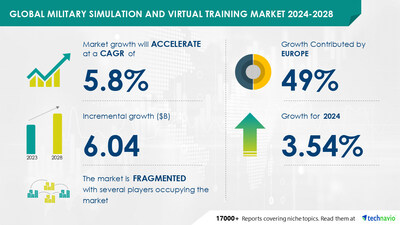Military Simulation and Virtual Training Market size is set to grow by USD 6.04 billion from 2024-2028, Cost-effectiveness of virtual training boost the market, Technavio
Press Releases
Jun 03, 2024
NEW YORK, June 3, 2024 /PRNewswire/ — The global military simulation and virtual training market size is estimated to grow by USD 6.04 billion from 2024-2028, according to Technavio. The market is estimated to grow at a CAGR of 5.8% during the forecast period.
For comprehensive forecast and historic data on regions, market segments, customer landscape, and companies- Click for the snapshot of this report
|
Military Simulation And Virtual Training Market Scope |
|
|
Report Coverage |
Details |
|
Base year |
2023 |
|
Historic period |
2018 – 2022 |
|
Forecast period |
2024-2028 |
|
Growth momentum & CAGR |
Accelerate at a CAGR of 5.8% |
|
Market growth 2024-2028 |
USD 6.04 billion |
|
Market structure |
Fragmented |
|
YoY growth 2022-2023 (%) |
3.54 |
|
Regional analysis |
North America, APAC, Europe, Middle East |
|
Performing market contribution |
Europe at 49% |
|
Key countries |
US, China, Russia, UK, and Germany |
|
Key companies profiled |
BAE Systems Plc, Bohemia Interactiv |
Market Driver
The military simulation and virtual training market are witnessing a significant trend towards portable simulators and head-mounted displays (HMDs). These solutions offer cost-effective alternatives to real-time training exercises, with the added benefits of portability and ease of transportation. Vendors like United Technologies Corp. and Meggitt PLC provide various portable simulators, such as Meggitt Training Systems’ FATS 100P virtual training system. HMDs, like Oculus Rift, are also gaining popularity for military training due to their small size, power, and cost-effectiveness.
Western militaries, including the US and British armies, are already utilizing these technologies for judgmental training and weapons handling analysis. The market for portable simulators and HMDs is expected to grow substantially during the forecast period.
The military simulation and virtual training market is experiencing significant growth, with various companies developing advanced systems. These systems include combat training, flight simulation, and tactical exercises. The use of virtual reality technology is becoming increasingly popular, allowing for more realistic and immersive training experiences.
The trend towards more realistic simulations is driven by the need for effective and efficient military preparation. Additionally, the integration of artificial intelligence and machine learning is enhancing the capabilities of these systems, providing more accurate and responsive training scenarios. Overall, the military simulation and virtual training market is an important sector, providing essential tools for military readiness and effectiveness.
Market Challenges
- The global military simulation and virtual training market faces challenges due to high costs. Factors include expensive simulation products and software, operating costs for simulators, and infrastructure needs such as space, personnel, and networking infrastructure. Peripherals like TV screens and controlling equipment also add to expenses. Certifications, which can be obtained from OEMs or training academies, further increase costs. These high operational expenses hinder market growth during the forecast period.
- The military simulation and virtual training market face several challenges in delivering effective and realistic training experiences. These include the need for advanced technology to create realistic environments, the requirement for large-scale simulations to train large forces, and the need for customizable scenarios to address specific mission requirements.
- Additionally, ensuring interoperability between different systems and maintaining up-to-date technology are ongoing challenges. Furthermore, integrating virtual training with real-world operations and measuring the effectiveness of training programs are also significant challenges in this market.
Research report provides comprehensive data on impact of trend, driver and challenges – Request a sample report!
Segment Overview
- Product
- 1.1 Flight simulators
- 1.2 Maritime simulators
- 1.3 Combat simulators
- Environment
- 2.1 Synthetic
- 2.2 Gaming
- Geography
- 3.1 North America
- 3.2 APAC
- 3.3 Europe
- 3.4 Middle East and Africa
- 3.5 South America
1.1 Flight simulators- The military simulation and virtual training market are experiencing significant growth due to the increasing demand for synthetic training environments and virtual boot camps. Two primary types of simulators exist: full-flight simulators (FFS) and flight simulation training devices (FSTD). Defense ministries worldwide utilize these simulators for pilot training. Haptic feedback simulations are also driving market growth, as they offer a more realistic training experience and reduce the cost of real-time simulations.
Technological collaborations among vendors are further fueling market expansion, enabling the creation of personalized and realistic haptic environments for pilots. For instance, Bohemia Interactive Simulations’ acquisition by BAE Systems will enhance modeling and simulation capabilities. Vendors are partnering to offer advanced simulators, such as Rockwell Collins’ Full Mission Rotary Wing Simulator used by the Indian Armed Forces for various training levels.
For more information on market segmentation with geographical analysis including forecast (2024-2028) and historic data (2017-2021) – Download a Sample Report
Research Analysis
The Military Simulation and Virtual Training market encompasses the development, implementation, and utilization of advanced technologies such as Virtual Reality (VR), Mixed Reality (MR), and Simulators for various military applications. These technologies enable the creation of immersive, realistic virtual scenarios for pilot training programs, air combat training, maritime security, and vehicle simulation.
The hardware and software components of these simulators include Air combat simulators, UAV and Drone simulators, VRAI, VRLT Programme, and Battlefield simulation systems. Skilled experts design and implement these systems for the Navy, Army, and Air Force to train personnel on complex tasks, including flying F-35 aircraft, operating tanks, and securing maritime borders. The integration of VR, MR, and simulators enhances the effectiveness and efficiency of military training programs.
Market Research Overview
The Military Simulation and Virtual Training market encompasses the development, implementation, and utilization of simulated environments for military personnel to acquire skills and knowledge. These simulations can range from basic training exercises to complex mission planning and execution scenarios. Virtual training provides a cost-effective and flexible alternative to traditional in-person training, allowing for the replication of various terrain types and combat situations.
The use of virtual reality technology further enhances the realism and immersion of these simulations, enabling more effective learning and preparation for real-world military operations. The market for military simulation and virtual training continues to grow as technology advances and the demand for effective and efficient training methods increases.
Table of Contents:
1 Executive Summary
2 Market Landscape
3 Market Sizing
4 Historic Market Size
5 Five Forces Analysis
6 Market Segmentation
- Product
- Flight Simulators
- Maritime Simulators
- Combat Simulators
- Environment
- Synthetic
- Gaming
- Geography
- North America
- APAC
- Europe
- Middle East And Africa
- South America
7 Customer Landscape
8 Geographic Landscape
9 Drivers, Challenges, and Trends
10 Company Landscape
11 Company Analysis
12 Appendix
About Technavio
Technavio is a leading global technology research and advisory company. Their research and analysis focuses on emerging market trends and provides actionable insights to help businesses identify market opportunities and develop effective strategies to optimize their market positions.
With over 500 specialized analysts, Technavio’s report library consists of more than 17,000 reports and counting, covering 800 technologies, spanning across 50 countries. Their client base consists of enterprises of all sizes, including more than 100 Fortune 500 companies. This growing client base relies on Technavio’s comprehensive coverage, extensive research, and actionable market insights to identify opportunities in existing and potential markets and assess their competitive positions within changing market scenarios.
Contacts
Technavio Research
Jesse Maida
Media & Marketing Executive
US: +1 844 364 1100
UK: +44 203 893 3200
Email: [email protected]
Website: www.technavio.com/
![]() View original content to download multimedia:https://www.prnewswire.com/news-releases/military-simulation-and-virtual-training-market-size-is-set-to-grow-by-usd-6-04-billion-from-2024-2028–cost-effectiveness-of-virtual-training-boost-the-market-technavio-302160496.html
View original content to download multimedia:https://www.prnewswire.com/news-releases/military-simulation-and-virtual-training-market-size-is-set-to-grow-by-usd-6-04-billion-from-2024-2028–cost-effectiveness-of-virtual-training-boost-the-market-technavio-302160496.html
SOURCE Technavio




